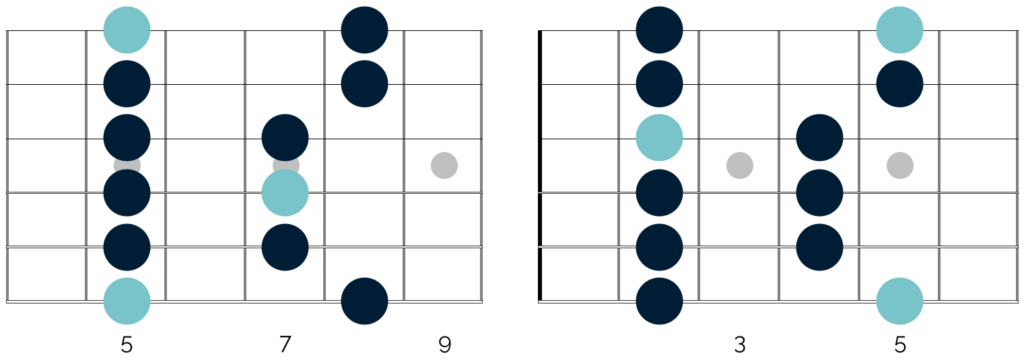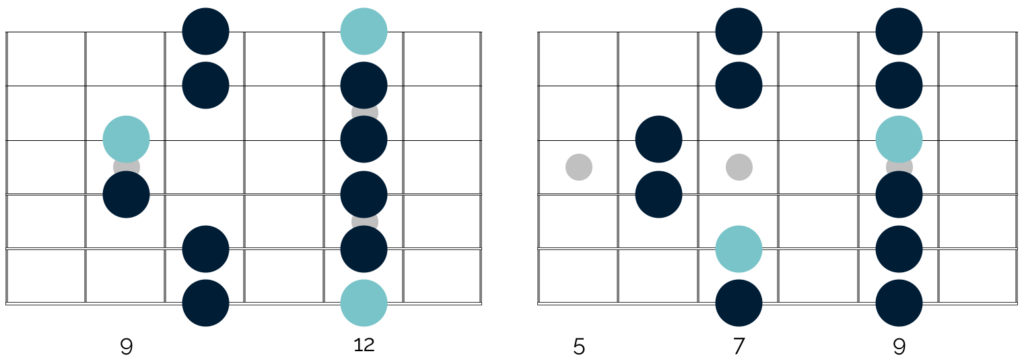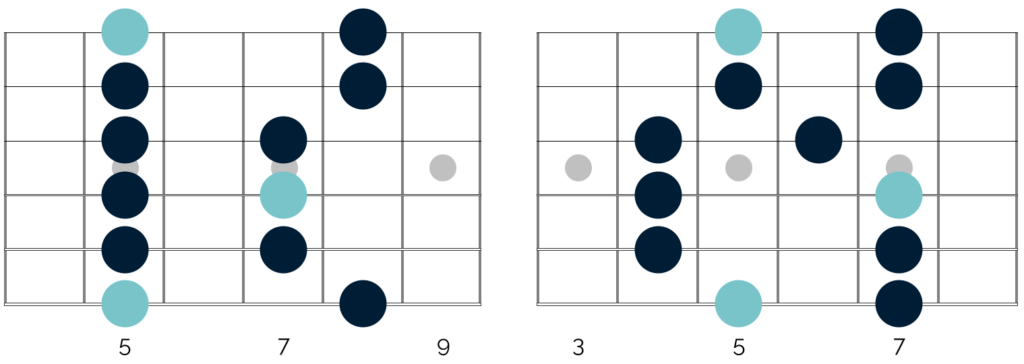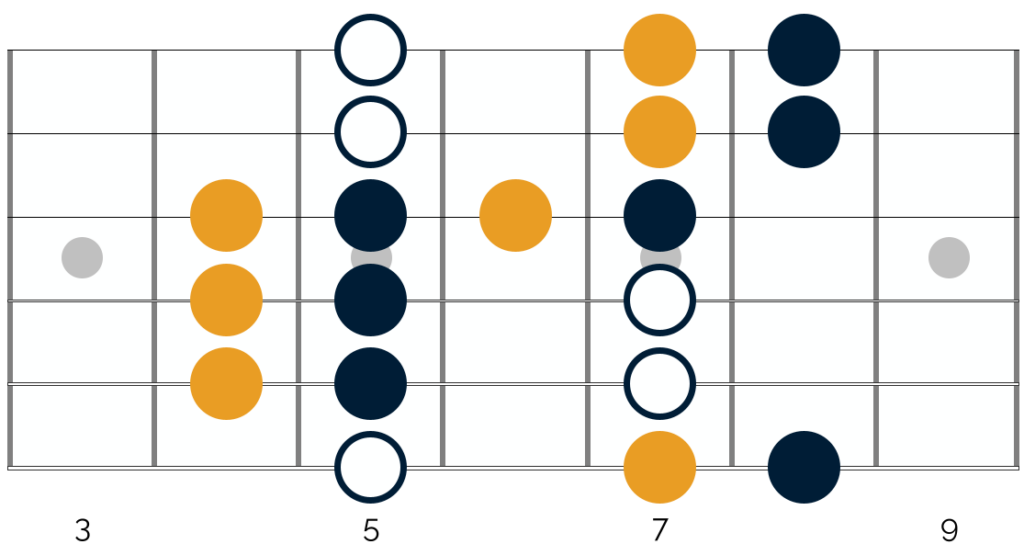When they are first learning the major pentatonic scale, a lot of guitarists utilise the major pentatonic ‘trick’ as a way of understanding where the shapes appear on the fretboard.
If this ‘trick’ is new to you, then it runs as follows:
If you take any shape of the minor pentatonic scale and move it down 3 frets, you will find the same shape of the major pentatonic scale.
In the key of A for example, this is where the first shapes of the minor and major pentatonic scales appear:

The diagram on the left shows the first shape of the A minor pentatonic scale, whilst the one on the right shows the first shape of the A major pentatonic.
As you can hopefully see, the scale shapes are identical. The only difference is that the shape of the major pentatonic scale appears 3 frets lower on the fretboard.
This is just one example, however the relationship exists in all keys and all shapes of the scale. We can see this if we compare the fifth shape of the E minor pentatonic scale with that of the E major pentatonic:

As you can see, the same relationship exists.
This trick is initially useful for helping you orientate where the shapes of the major pentatonic scale exist in any given key.
Beyond that however, I would argue that continuing to view the relationship between the minor and major pentatonic scales in this way is preventing you from using the major pentatonic scale effectively.
In this week’s quick win lesson, I will explain why this is the case, and the alternative that will help you to start soloing freely with the scale.
Let’s get into it!
In my opinion, there are two significant problems with the major pentatonic ‘trick’. And these are as follows:
Problem #1 – Diminished differences
The major and minor pentatonic scales are fundamentally different.
Whilst the shapes of the scales are the same, the intervals and notes that appear within them are not. Understanding this is crucial, as it impacts how the scales sound and the musical contexts in which you can use them.
You can appreciate this without understanding or looking at any theory. All you need to do is listen to the sound of the scales.
The minor pentatonic scale has a more aggressive and melancholic sound, whilst the major pentatonic has a more upbeat and mellow sound.
You can hear this in the songs and solos in which the scales are featured. Just some of the many songs that use the minor pentatonic scale are as follows:
- Hey Joe – Jimi Hendrix
- Whole Lotta Love – Led Zeppelin
- Going Down – Freddie King
- Scuttle Buttin’ – Stevie Ray Vaughan
Just some of the many songs that use the major pentatonic scale are as follows:
- Why I Sing The Blues – B.B. King
- Blue Sky – The Allman Brothers Band
- All Right Now – Free
- Gravity – John Mayer
Of course, there are more intense and aggressive blues songs that utilise the major pentatonic scale, and those which are more mellow and upbeat which utilise the minor pentatonic. Hopefully though the songs in the lists above give you a sense of the different characters of the scales.
This difference exists because the scales have different tonalities. The minor pentatonic scale contains a minor 3rd or b3 interval. By comparison, the major pentatonic scale contains a major 3rd or 3 interval.
You can see this when we look at the intervals in both scales. The intervals in the major pentatonic scale are as follows:
1 2 3 5 6
In the minor pentatonic scale, by comparison, they are as follows:
1 b3 4 5 b7
The scales do share certain intervals and therefore certain notes. Specifically, they both share the 1st and 5th intervals. Expressed another way, they both share the notes of A and E.
That however, is where the similarities end. We can see this by looking at the following summary table:
| Scale | Intervals | Notes |
| A Major Pentatonic Scale | 1 2 3 5 6 | A B C# E F# |
| A Minor Pentatonic Scale | 1 b3 4 5 b7 | A C D E G |
This might sound obvious. However because the scale shapes are the same, a lot of players fall into the trap of thinking that the scales are in fact the same. This is just not the case.
What then often happens is that guitarists try to recreate their ‘go-to’ minor pentatonic licks by shifting them 3 frets down. Yet this doesn’t work particularly well.
Phrase capping
A big reason for this is that the blues relies on you effectively ‘capping’ your phrases when soloing. If you listen to any famous blues guitarists, you will hear that each phrase they play sounds complete. It sounds like a fully formed musical idea with an obvious stopping or pausing point.
This is because they are finishing their phrases on particular notes which either create tension or resolution, and they are doing so intentionally.
To go into which notes from the pentatonic scales create tension and resolution is beyond the scope of this article.
However we can explore it briefly by looking at the tonic. The tonic note is the note of the key in which you are playing. So in the key of A, the note of A is the tonic. In the key of C, C is the tonic and so on.
When you play the tonic, you are playing a note devoid of musical tension. It sounds perfectly resolved and as such is a great way to bring your phrases to an effective conclusion.
Looking at just this one note is enough to illustrate why shifting your ‘go-to’ blues licks down 3 frets to the major pentatonic scale is ineffective.
We can see this if we return to the earlier scale diagrams:

In both diagrams the tonic notes are highlighted in light blue. As you can see then, even though the scale shapes are the same, the position of the tonic notes are not.
This difference extends to all of the notes in the scale, all of which create a particular sound and perform a specific musical function.
For this reason, taking your ‘go-to’ minor pentatonic licks and simply moving them down 3 frets doesn’t work particularly well.
Problem #2 – Impracticality
The second weakness of the major pentatonic trick, is that it is quite impractical. Even if you could simply shift all of your minor pentatonic licks down 3 frets, I would still not advocate this approach.
This is because I believe it is important to have choices in any given position of the fretboard. In this way you can craft a range of interesting ideas without being forced to move into new or different positions.
If you then want to move into a new position, you can do so. However you want to have the choice. In other words, you don’t want to have to move into a new position to execute a particular idea.
When guitarists become overly fixated on the major pentatonic ‘trick’, they fall into this trap. They end up with only one mechanism for moving between the major and minor pentatonic scales.
If and when these players work out how to create interesting and effective licks with the major pentatonic scale, their solos never truly flow effectively.
They find themselves continually navigating up and down the fretboard between the minor and major scales, without being able to connect them in a smooth and musical way. This is problematic and the pentatonic ‘trick’ is responsible for guitarists ending up in this position.
The alternative
Hopefully by this point I have convinced you that the major pentatonic ‘trick’ is not the best option for targeting the scale in your playing. Understandably though, you might be wondering what is the most effective alternative.
In short, it is to appreciate the ways the two scales overlap in any given section of the fretboard. Understanding this relationship is simple.
Whenever you find a shape of the minor pentatonic scale, you will find the next shape of the major pentatonic scale in the same position.
In other words, the second shape of the major pentatonic scale crosses over with the first shape of the minor pentatonic scale. The third shape of the major scale crosses over with the second shape of the minor pentatonic scale, and so on.
I illustrate this from the 28 second mark in the video above, when I play the following two scale shapes:

As you can see, the first shape of the minor pentatonic and the second shape of the major pentatonic scale appear in the same section of the fretboard.
Whilst these scales do share some of the same notes, many of them are different.
We can see this if we consolidate the two scales and look at them together on the fretboard as a single group of notes, rather than as two separate diagrams:

The notes shown here in dark blue are those which appear in just the minor pentatonic scale.
Those shown in white are those which appear in both the minor and the major pentatonic scales.
Lastly, those in yellow are the ‘new’ notes from the major pentatonic scale.
When the two scale shapes are presented in this way, hopefully you can see how adding the major pentatonic scale into the mix greatly increases the density of notes available to you.
You can also see how much overlap there is between the major and minor pentatonic scale in any given position.
Far from having to move around the fretboard to target the major pentatonic, when viewed in this way you can see how easy it is to find notes from the scale, regardless of where you are on the fretboard.
Getting started
How to target these notes effectively and actually include them in your phrases is a more extensive challenge and one that I will cover in future quick win lessons.
However the first step that we have covered in this lesson is important for two reasons:
Firstly, it moves you towards a more practical appreciation of the scale. In any given position on the fretboard you understand how the minor and major pentatonic scales overlap, and don’t need to continually move back 3 frets to gain your bearings.
Secondly and significantly, it puts you into a position where you can start to experiment with the major pentatonic scale. If you have relied on the major pentatonic ‘trick’ up to this point, then it is unlikely that you have crafted a range of killer licks using the major pentatonic scale.
This is because this ‘trick’ forces you to move completely from the minor to the major pentatonic. In other words, it moves you from a scale with which you (hopefully) feel comfortable to one that feels much less familiar.
This switch is harsh and unsettling, and makes it difficult to start creating ideas using the major pentatonic.
Now though, you can start to experiment with the major pentatonic from a position of security and comfort. Instead of having to move from the minor pentatonic to the major pentatonic, you can focus on predominantly playing using the minor pentatonic scale.
From there you can then begin to add notes in from the major pentatonic to alter the sound of your licks.
This is an idea that I will cover in more detail in my next quick win lesson. So before then, just spend a little time getting used to this crossover, and begin to experiment in a key and section of the fretboard with which you are familiar and comfortable.
Good luck, and I’ll see you next time! 😁
